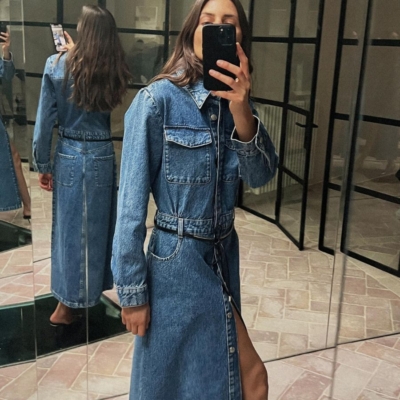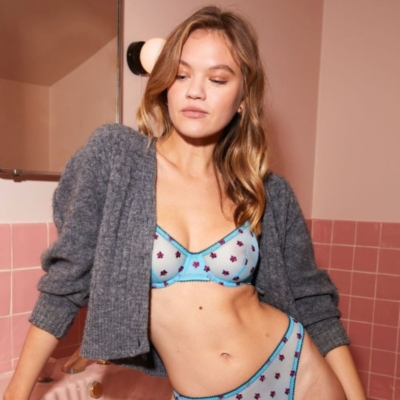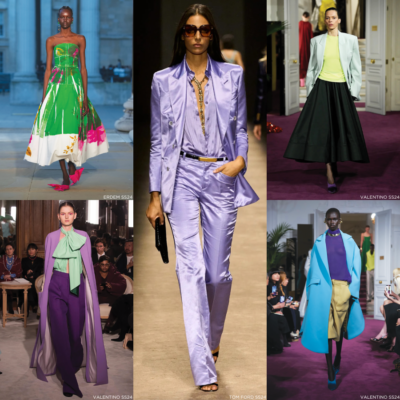Shopping for fashion online has become the norm. As designers and brands diverge wildly on size and fit, to avoid disappointment – and endless returns – arm yourself with some insider information …
Not only have we, collectively, fluctuated in size over the past few years – the corona stone has been a reality for many – but who hasn’t grappled with online versus in-person shopping, making an online purchase only to realise a size 12 in one brand is the equivalent to a size 8 in another? The fact that we can’t see and try on the clothes when purchasing online has added to the ambiguity around the sizing of women’s clothes. Unlike the purchase of menswear which has a verified fit, buying womenswear – with its wild divergence in size and fit across brands and designers – is a fraught, emotional issue.
Owner of Dublin boutique Havana Nikki Creedon is sympathetic. “There isn’t a uniform approach among designers. Trial and error and getting to know the brands really helps, whether buying online or over the phone with a boutique owner. The Vampire’s Wife for instance, has a very neat fit and we always advise taking a size up. When buying jeans many people stick to the same brand once they become au fait with the sizing.” (On the subject of jeans, who can forget Chloe Martin’s tweet, which went viral, showing five pairs of jeans she purchased in a size 12 from different retailers. The waistline of each was different, reinforcing the fact that designers often rely on “vanity sizing” – or is it “insanity sizing”? – with a haphazard notion of fit.) “When I worked with Paul Costelloe in the 1980s,” says Creedon, “he was the first designer to size down, which gave women a psychological boost. His size 6 was the equivalent to a size 8 and so on. We try to tell our customers not to get hung up on the sizes on the labels, it’s best to engage some help.”
The average woman’s size in Ireland is 14; in the US and UK it’s an 18, apparently. According to Buying Director of Brown Thomas, Shelly Corkery, the average Brown Thomas designerwear customer is a size 10-12. To find a size 14 or larger, Corkery recommends Dries van Noten, Bottega Veneta and Jil Sander. Prada too runs up to a EU44.
Clodagh Shorten, owner of Cork boutique Samui, which celebrates 20 years in business this year, says her customer base at the moment is at the smaller end of the scale (size 10-12). She buys collections according to fit. Her most popular brands, from Zadig & Voltaire and Ulla Johnson to Dorothee Schumacher, all have their sizing nuances, which Shorten navigates for clients. During lockdown, Shorten regularly advised customers via WhatsApp appointments, while she and her staff (who are all different sizes) frequently model the clothes on InstaStories.
Size fluctuations vary not only by designer, but are determined in many cases by fit models and manufacturers. Someone with firsthand experience of this is former fit model Louise O’Reilly of blog Style Me Curvy. “Fit models have a very important role in fashion and sizing, helping identify issues with a garment that could impact sales. When a brand suddenly changes its fit model to slightly different proportions, this can affect their overall size and product fit.” Where a garment is made can also affect size. “This is more relevant to high street and online retailers who buy products in large quantities from manufacturers all over the world,” says O’Reilly. “It is not uncommon for brands to have suppliers in different countries which can often lead to disparities in sizes across the same brand.”
It’s been estimated that customers return approximately 40 per cent of what they buy online, mostly because of sizing issues.
Decoding descriptions and fabrics is also a useful skill. “I always suggest looking at the fabric and cut,” says Sadhbh Fahy, owner of Electra boutique in Dublin 4. Fahy has seen a huge spike in online sales since launching her portal in 2020. “If something is made in a rigid fabric it’s likely to be smaller fitting. Conversely, a soft wool or wool mix fabric is more likely to be on the loose side. We mention sizing on the website where we think it differs from the norm for the brand.”
Insider information such as this is valuable for online shoppers, where shoppers can rely on brand knowledge (via an informed boutique owner). Without a real person with an intimate knowledge of the designer or brand, how best to approach online shopping and sizes? Firstly, it helps to scan your wardrobe for the type of item you wear most, looking at the sizes you typically buy. This gives a guide to the silhouette you’ll be safest buying online. You must also know your measurements. You’d be surprised how many of us don’t. I have a somewhat nebulous notion of my actual size in centimetres and inches, but my colleague Tracy Ormiston is meticulous. “Having shopped online for over 20 years, I keep a record of my weight, height and measurements to hand and a small tape measure in my bag. This is very handy for all measurements including handbag dimensions and heel heights! I also refer to my order history, which helps confirm what size fits best.”
Second, online shoppers use sophisticated tools which are widely available now. These have become more precise and are now very thorough, particularly with high street brands who have evolved technology fastest (as seen across the Spanish Inditex brands Mango, Zara and Massimo Dutti, with an honourable mention here for H&M whose accurate algorithm includes age, weight, height and the sizes you typically buy in other brands). Taking customers through a short quiz about weight, height, shape, age and fit preference (from slim to loose), means shoppers can cross-reference their own measurements against the brand’s equivalent sizes. Once these preferences are plugged in, every single time you return to that site and start to browse items, your recommended size will be suggested for each.
And this technology will just keep evolving. In the US, Sizecharter.com is a popular tool. It enables women to plug in their measurements, which it will return with a list of best brands for body type. It doesn’t guarantee a perfect fit every time but it does help. Boston-based True Fit works with more than 10,000 brands. Its algorithm asks shoppers to enter the size and brand of their best-fitting shoe, shirt, dress, and so on before recommending products accordingly. The Meepl and Body Labs apps both take three-dimensional body scans. Amazon recently patented a True Fit-like algorithm, while Fame & Partners even allows shoppers to design their own dresses.
Brand knowledge, having (honest and up-to-date!) personal measurements to hand and technological advancements all help to minimise shopping disappointment. These measures can also, crucially, prevent the wastefulness and the environmental cost of returning goods. It’s been estimated that customers return approximately 40 per cent of what they buy online, mostly because of sizing issues. This is unsustainable waste and is costly for retailers who spend billions on free returns, not to mention irritating for those of us who regularly find ourselves joining a queue at the post office, cardboard boxes in hand. And as for the psychological mood-dip that can come when an item arrives and it doesn’t fit, or it’s too small? We say: do not despair. It’s worth noting Emma Gleeson’s wise words from her book Stuff Happens: “The narrative around clothing that we have internalised is that if an item does not fit or suit you, your body is wrong for the clothes. Practise repeating the thought that it is the clothes that are wrong for the body, not the other way around.”
LOVETHEGLOSS.IE?
Sign up to our MAILING LIST now for a roundup of the latest fashion, beauty, interiors and entertaining news from THE GLOSS MAGAZINE’s daily dispatches.









